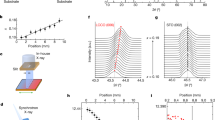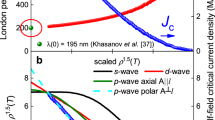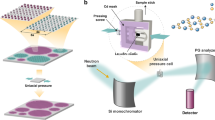Abstract
In conventional superconductors, the interaction that pairs the electrons to form the superconducting state is mediated by lattice vibrations1 (phonons). In high-transition-temperature (high-Tc) copper oxides, it is generally believed that magnetic excitations might play a fundamental role in the superconducting mechanism because superconductivity occurs when mobile ‘electrons’ or ‘holes’ are doped into the antiferromagnetic parent compounds2. Indeed, a sharp magnetic excitation termed ‘resonance’ has been observed by neutron scattering in a number of hole-doped materials3,4,5,6,7,8,9,10,11. The resonance is intimately related to superconductivity12, and its interaction with charged quasi-particles observed by photoemission13,14, optical conductivity15, and tunnelling16 suggests that it might play a part similar to that of phonons in conventional superconductors. The relevance of the resonance to high-Tc superconductivity, however, has been in doubt because so far it has been found only in hole-doped materials17. Here we report the discovery of the resonance in electron-doped superconducting Pr0.88LaCe0.12CuO4-δ (Tc = 24 K). We find that the resonance energy (Er) is proportional to Tc via Er ≈ 5.8kBTc for all high-Tc superconductors irrespective of electron- or hole-doping. Our results demonstrate that the resonance is a fundamental property of the superconducting copper oxides and therefore must be essential in the mechanism of superconductivity.
This is a preview of subscription content, access via your institution
Access options
Subscribe to this journal
Receive 51 print issues and online access
$199.00 per year
only $3.90 per issue
Buy this article
- Purchase on Springer Link
- Instant access to full article PDF
Prices may be subject to local taxes which are calculated during checkout




Similar content being viewed by others
References
Bardeen, J., Cooper, L. N. & Schrieffer, J. R. Theory of superconductivity. Phys. Rev. 108, 1175–1204 (1957)
Orenstein, J. & Millis, A. J. Advances in the physics of high-temperature superconductivity. Science 288, 468–474 (2000)
Rossat-Mignod, J. et al. Neutron scattering study of the YBa2Cu3O6+x system. Physica C 185, 86–92 (1991)
Mook, H. A. et al. Polarized neutron determination of the magnetic excitations in YBa2Cu3O7 . Phys. Rev. Lett. 70, 3490–3493 (1993)
Fong, H. F. et al. Spin susceptibility in underdoped YBa2Cu3O6+x . Phys. Rev. B 61, 14773–14786 (2000)
Dai, P., Mook, H. A., Hunt, R. D. & Doğan, F. Evolution of the resonance and incommensurate spin fluctuations in superconducting YBa2Cu3O6+x . Phys. Rev. B 63, 054525 (2001)
Stock, C. et al. Dynamic stripes and resonance in the superconducting and normal phases of YBa2Cu3O6.5 ortho-II superconductor. Phys. Rev. B 69, 014502 (2004)
Hayden, S. M., Mook, H. A., Dai, P., Perring, T. G. & Doğan, F. The structure of the high-energy spin excitations in a high-transition-temperature superconductor. Nature 429, 531–534 (2004)
Fong, H. F. et al. Neutron scattering from magnetic excitations in Bi2Sr2CaCu2O8+δ . Nature 398, 588–591 (1999)
He, H. et al. Resonant spin excitations in a overdoped high temperature superconductor. Phys. Rev. Lett. 86, 1610–1613 (2001)
He, H. et al. Magnetic resonant mode in the single-layer high-temperature superconductor Tl2Ba2CuO6+δ . Science 295, 1045–1047 (2002)
Dai, P. et al. The magnetic excitation spectrum and thermodynamics of high-Tc superconductors. Science 284, 1344–1347 (1999)
Damascelli, A., Hussain, Z. & Shen, Z.-X. Angle-resolved photoemission studies of the cuprate superconductors. Rev. Mod. Phys. 75, 473–541 (2003)
Norman, M. R. & Pepin, C. The electron nature of high temperature cuprate superconductors. Rep. Prog. Phys. 66, 1547–1610 (2003)
Basov, D. N. & Timusk, T. Electrodynamics of high-Tc superconductors. Rev. Mod. Phys. 77, 721–779 (2005)
Zasadzinski, J. F. et al. Correlation of tunneling spectra in Bi2Sr2CaCu2O8+δ with the resonance spin excitation. Phys. Rev. Lett. 87, 067005 (2001)
Hwang, J., Timusk, T. & Gu, G. D. High-transition-temperature superconductivity in the absence of the mangetic-resonance mode. Nature 427, 714–717 (2004)
Arai, M. et al. Incommensurate spin dynamics of underdoped superconductor YBa2Cu3O6.7 . Phys. Rev. Lett. 83, 608–611 (1999)
Bourges, P. et al. The spin excitation spectrum in superconducting YBa2Cu3O6.85 . Science 288, 1234–1237 (2000)
Tranquada, J. M. et al. Quantum magnetic excitations from stripes in copper oxide superconductors. Nature 429, 534–538 (2004)
Christensen, N. B. et al. Dispersive excitations in the high-temperature superconductor La2-xSrxCuO4 . Phys. Rev. Lett. 93, 147002 (2004)
Tranquada, J. M. Neutron scattering studies of antiferromagnetic correlations in cuprates. Preprint at http://arXiv.org/cond-mat/0512115 (2005).
Dai, P. et al. Electronic inhomogeneity and competing phases in electron-doped superconducting Pr0.88LaCe0.12CuO4-δ . Phys. Rev. B 71, 100502(R) (2005)
Kang, H. J. et al. Electronically competing phases and their magnetic field dependence in electron-doped nonsuperconducting and superconducting Pr0.88LaCe0.12CuO4-δ . Phys. Rev. B 71, 214512 (2005)
Yamada, K. et al. Commensurate spin dynamics in the superconducting state of an electron-doped cuprate superconductor. Phys. Rev. Lett. 90, 137004 (2003)
Fujita, M. et al. Magnetic and superconducting phase diagram of electron-doped Pr1-xLaCexCuO4 . Phys. Rev. B 67, 014514 (2003)
Boothroyd, A. T., Doyle, S. M., Paul, McK. D. & Osborn, R. Crystal-field excitations in Nd2CuO4, Pr2CuO4, and related n-type superconductors. Phys. Rev. B 45, 10075–10086 (1992)
Kivelson, S. A. et al. How to detect fluctuating stripes in the high-temperature superconductors. Rev. Mod. Phys. 75, 1201–1241 (2003)
Aronson, M. C. et al. Non-Fermi-liquid scaling of the magnetic response in UCu5-xPdx (x = 1, 1.5). Phys. Rev. Lett. 75, 725–728 (1995)
Matsui, H. et al. Direct observation of a nonmonotonic d x2-y2-wave superconducting gap in the electron-doped high-Tc superconductor Pr0.89LaCe0.11CuO4 . Phys. Rev. Lett. 95, 017003 (2005)
Acknowledgements
We thank E. Dagotto, H. Ding and S. Zhang for discussions. We also thank Y. Ando's group for teaching us how to grow high-quality single crystals of PLCCO. S.D.W. and S.L. are supported by the US National Science Foundation. S.C. is supported by the US DOE Division of Materials Science, Basic Energy Sciences. Oak Ridge National Laboratory is supported by the US DOE through UT/Battelle LLC. SPINS is supported by the US National Science Foundation through the Center for High Resolution Neutron Spectroscopy.
Author information
Authors and Affiliations
Corresponding author
Ethics declarations
Competing interests
Reprints and permissions information is available at npg.nature.com/reprintsandpermissions. The authors declare no competing financial interests.
Supplementary information
Supplementary Discussion 1
This file contains Supplementary Notes and Supplementart Figure 1, showing model calculations for various CEF transitions. Arguments are presented ruling out the possibility of a CEF origin to the magnetic resonance mode we observe, and the CEF excitation influence can be regarded as background scattering underneath the spin fluctuations localized at Q=(0.5, 0.5, 0). (PDF 237 kb)
Rights and permissions
About this article
Cite this article
Wilson, S., Dai, P., Li, S. et al. Resonance in the electron-doped high-transition-temperature superconductor Pr0.88LaCe0.12CuO4-δ. Nature 442, 59–62 (2006). https://doi.org/10.1038/nature04857
Received:
Accepted:
Issue Date:
DOI: https://doi.org/10.1038/nature04857
This article is cited by
-
Antinodal kink in the band dispersion of electron-doped cuprate La2−xCexCuO4±δ
npj Quantum Materials (2022)
-
Resonance from antiferromagnetic spin fluctuations for superconductivity in UTe2
Nature (2021)
-
Existence of Pseudogap at the Transition Temperature of an Electron-Doped Copper–Oxide Superconductor
Journal of Superconductivity and Novel Magnetism (2014)
-
Close relationship between superconductivity and the bosonic mode in Ba0.6K0.4Fe2As2 and Na(Fe0.975Co0.025)As
Nature Physics (2013)
-
Emerging superconductivity hidden beneath charge-transfer insulators
Scientific Reports (2013)
Comments
By submitting a comment you agree to abide by our Terms and Community Guidelines. If you find something abusive or that does not comply with our terms or guidelines please flag it as inappropriate.



